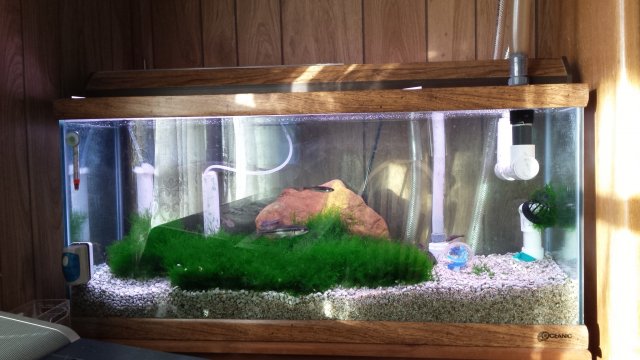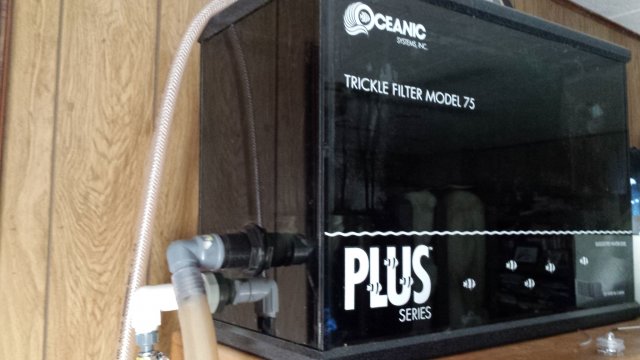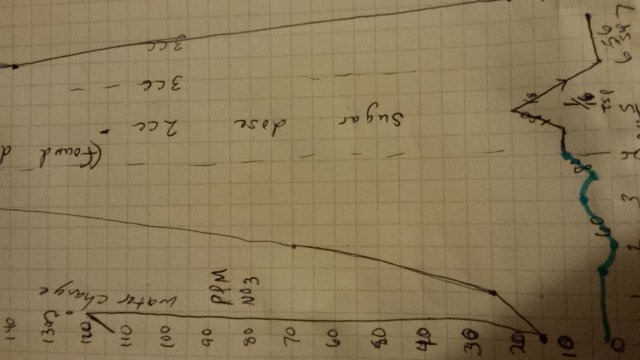Hi. This is my first post ever about aquariums.
For starters I have a formal education in waste water treatment. I have recently got back into fish keeping after 20 years of absence. I have 10 years of old school behind me.
Well I once had a 20 g long that used crushed lava rock. That was nitrate free. Lightly stocked and the water fleas kept the fish fed.
So recently I cleaned up the old ,Oceanic trickle filter model 75. Plumbed it into a 30 gallon Oceanic. Yes way over kill.
Then went to my local fish store to get some substrate. When I encountered the generational gap in 1001 to plumb a fish tank. Well a lot of misinformation so I thought I will experiment a bit.
Which is why the pvc pipeing is kind of crazy in the pictures.
To get to the point. Water changes are not required to remove nitrates from a fresh water aquarium.
Nitrogen gas production from nitrate does not smell, any worse than a well maintained cat litter box.
300ppm nitrate can be absorbed in less than a week. Maybe even faster with a starter culture.
I am open too new ideas, like purigen and led lights.
Well my budget is limited so I like DIY things.
My 30 gallon setup.
Undergravel filter plates.
Crushed pumice 50/50 course sand. 4" deep
Hob filter for 55 gallon. Used as UG filter vacume, and drip siphon head.
Oceanic trickle filter at 400 gph.
DIY 1 gpd anarobic nitrogen gas bubbler
The UG is reverse flowed at about 5 gpd. Fast drip. With a siphon from the HOB.
The model 75. Provides full oxygen and bacterial filtration if the UG filter crashes from experimental dosing with vodka, sugar.
Water is siphoned from 30 into pump. Then into sump. That is above tank. Note. Sump has baffle to prevent other tank from flooding.





For starters I have a formal education in waste water treatment. I have recently got back into fish keeping after 20 years of absence. I have 10 years of old school behind me.
Well I once had a 20 g long that used crushed lava rock. That was nitrate free. Lightly stocked and the water fleas kept the fish fed.
So recently I cleaned up the old ,Oceanic trickle filter model 75. Plumbed it into a 30 gallon Oceanic. Yes way over kill.
Then went to my local fish store to get some substrate. When I encountered the generational gap in 1001 to plumb a fish tank. Well a lot of misinformation so I thought I will experiment a bit.
Which is why the pvc pipeing is kind of crazy in the pictures.
To get to the point. Water changes are not required to remove nitrates from a fresh water aquarium.
Nitrogen gas production from nitrate does not smell, any worse than a well maintained cat litter box.
300ppm nitrate can be absorbed in less than a week. Maybe even faster with a starter culture.
I am open too new ideas, like purigen and led lights.
Well my budget is limited so I like DIY things.
My 30 gallon setup.
Undergravel filter plates.
Crushed pumice 50/50 course sand. 4" deep
Hob filter for 55 gallon. Used as UG filter vacume, and drip siphon head.
Oceanic trickle filter at 400 gph.
DIY 1 gpd anarobic nitrogen gas bubbler
The UG is reverse flowed at about 5 gpd. Fast drip. With a siphon from the HOB.
The model 75. Provides full oxygen and bacterial filtration if the UG filter crashes from experimental dosing with vodka, sugar.
Water is siphoned from 30 into pump. Then into sump. That is above tank. Note. Sump has baffle to prevent other tank from flooding.












